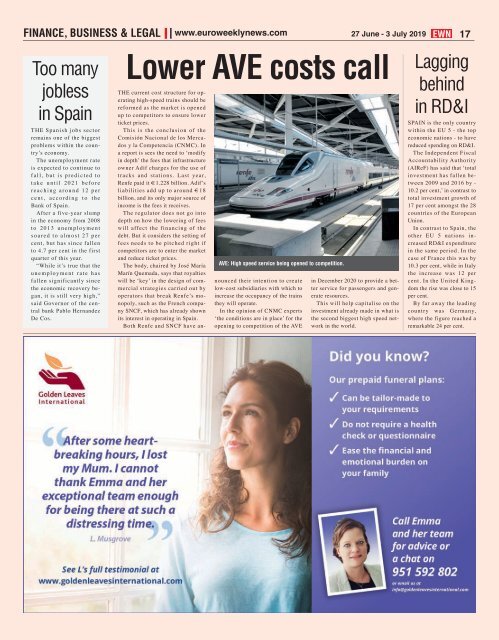16 EWN 27 June - 3 <strong>July</strong> <strong>2019</strong> www.euroweeklynews.com FINANCE, BUSINESS & LEGAL LONDON - FTSE 100 CLOSING PRICES JUNE <strong>24</strong> COMPANYOMPANY PRICE(P) CHANGE(P) % CHGC HG. NETET VOLOL ADMIRAL GROUP 21,620 2,60 0,55 74.063 ANGLO AMERICAN 21,655 0,45 0,10 113.938 ANTOFAGASTA 8,964 0,07 0,01 45.707 ASHTEAD GROUP 21,970 2,14 0,46 65.9<strong>18</strong> ASTRA ZENECA 64,140 0,56 0,36 142.973 BABCOCK INTE 4,793 0,76 0,04 31.386 BARCLAYS BANK 1,489 0,11 0,00 2.205.691 BARRATT DEVE 5,596 -0,56 -0,03 74.797 BAT INDUSTRI 27,795 -0,63 -0,17 269.332 BILLITON 19,690 0,10 0,02 213.788 BP 5,569 0,13 0,01 1.210.758 BRIT.AEROE 4,877 0,52 0,02 155.573 BRITISH FOODS <strong>24</strong>,310 -0,42 -0,10 17.671 BRITISH LAND 5,402 -0,05 -0,00 151.050 BRITISH TELECOM 1,989 -0,80 -0,02 1.869.312 BUNZL 21,480 1,78 0,38 29.953 BURBERRY 17,920 0,50 0,09 81.4<strong>18</strong> CARNIVAL PLC 34,110 -2,56 -0,90 66.285 CELLTECH 29,770 0,20 0,06 42.754 CENTRICA 0,883 -0,23 -0,00 1.514.953 CGNU 4,140 -0,72 -0,03 322.599 CONVATEC GROUP 1,434 1,16 0,02 39.102 CRH 25,420 -0,47 -0,12 37.491 CRODA INTERN 53,850 0,46 0,25 19.563 DCC ORD IEP0 71,160 0,38 0,27 3.352 DELLING GRP 3,255 0,62 0,02 325.067 DIAGEO 34,070 0,94 0,32 134.708 EASYJET 8,776 -0,63 -0,06 228.903 EXPERIAN GROUP LTD <strong>24</strong>,320 0,48 0,12 29.657 FRESNILLO 8,926 1,06 0,09 82.654 GLAXO WELLCO 15,842 0,77 0,12 423.801 GLENCORE INTL 2,809 0,25 0,01 1.565.439 GROUP 4 SECU 2,116 -0,38 -0,01 79.973 HAMMERSON 2,770 -2,13 -0,06 360.312 HARGREAVES LANSDOWN <strong>18</strong>,993 -0,05 -0,01 42.175 HSBC 6,477 -0,41 -0,03 1.142.741 IMPERIAL TOBACCO <strong>18</strong>,686 -0,09 -0,02 166.275 INFORMA GROU 8,154 0,74 0,06 77.123 INTERCON.HOT 51,450 -0,20 -0,10 12.977 INTERTEK GROUP 56,580 1,51 0,84 10.107 INTL CONSOLIDATED AIRLINES GRP4,558 0,26 0,01 405.405 ITV 1,075 0,05 0,00 297.714 JOHNSON MATT 31,720 -0,64 -0,20 13.700 KINGFISHER 2,052 -1,25 -0,03 689.645 LAND SECURIT 8,312 -0,17 -0,01 121.<strong>24</strong>4 COMPANY PRICE(P) CHANGE(P) % CHGC HG. NET VOL LEGAL & GENERAL 2,667 0,09 0,00 523.937 LLOYDS BANK 0,579 -0,34 -0,00 8.878.525 LONDON STOCK 55,360 0,65 0,36 12.302 MARKS & SPENCER 2,100 0,10 0,00 321.889 MEDIA CONTEN 3,063 0,60 0,02 84.846 MERLIN ENTERTAINMENTS 3,983 1,89 0,07 129.464 MICRO FOCUS 20,210 0,95 0,19 42.617 MONDI PLC 17,620 -0,30 -0,05 44.143 MORRISON SUP 1,997 -0,32 -0,01 306.528 NEXT 56,540 0,35 0,20 17.845 PEARSON 8,216 0,69 0,06 80.298 PERSIMMON 19,355 -0,73 -0,14 20.738 PROV.FINANC. 4,157 0,10 0,00 46.204 PRUDENTIAL C 16,885 -0,56 -0,09 157.342 RAMBLER MED. 2,046 -1,26 -0,03 109.389 RECKITT BNKR 62,480 -1,00 -0,63 51.856 REED INTER 19,515 1,53 0,30 316.358 RENTOKIL GRP 3,988 -0,22 -0,01 <strong>18</strong>6.003 RIO TINTO 47,190 0,74 0,35 85.561 ROLLS ROYCE 9,010 0,77 0,07 232.272 ROYAL & SUN 5,712 -0,39 -0,02 69.985 ROYAL BANK OF SCOTLAND 2,160 0,14 0,00 348.177 ROYAL DUTCH SHELL B SHARES26,050 -0,12 -0,03 259.014 ROYAL DUTCH SHELL CL.A NLD 25,965 0,19 0,05 4<strong>24</strong>.7<strong>24</strong> SAGE GROUP 7,938 0,83 0,07 53.688 SAINSBURY 1,923 -1,84 -0,04 360.298 SCHRODERS 30,600 -0,46 -0,14 6.491 SCOT.& STH 11,115 -0,20 -0,02 251.969 SEVERN TRENT 20,950 -0,63 -0,13 46.858 SKILLSGROUP 23,450 -3,71 -0,90 17.563 SLOUGH EST. 7,412 -0,02 -0,00 198.<strong>24</strong>7 SMITH & NEP. 17,235 0,38 0,06 46.372 SMITHS INDU. 15,<strong>24</strong>5 0,69 0,10 30.743 ST JAMES S P 10,945 -1,17 -0,13 44.554 STAN.CHART 6,976 -1,03 -0,07 392.269 STANDARD LIFE 2,897 -0,<strong>24</strong> -0,01 405.883 TAYLOR WOOD. 1,563 -0,48 -0,01 358.541 TESCO 2,3<strong>24</strong> -1,82 -0,04 1.662.422 TUI 7,152 -1,84 -0,13 123.654 UNILEVER 49,390 1,14 0,56 125.972 UN.UTILITIES 8,058 0,60 0,05 95.092 VODAFONE GRP 1,269 -0,38 -0,00 3.349.757 WHITBREAD 44,990 0,10 0,04 30.154 WPP GROUP 9,7<strong>18</strong> -0,06 -0,01 151.854 3I GROUP 10,645 0,14 0,02 46.088 MAKE THE MOST OF YOUR MONEY WITH US Units per € US dollar ................................................1.13769 Japan yen...............................................122.213 Switzerland franc ...................................1,11225 Denmark kroner .....................................7,46617 Norway kroner........................................9,65537 DOW JONES CLOSING PRICES JUNE <strong>24</strong> See our advert on previous page 0.89395 1.1<strong>18</strong>62 currenciesdirect.com/marbella • Tel: +34 952 906 581 THE ABOVE TABLE USES THE CURRENT INTERBANK EXCHANGE RATES, WHICH AREN’T REPRESENTATIVE OF THE RATE WE OFFER COMPANY PRICE CHANGE% CHANGE VOLUME(M) AMERICAN EXPRESS 1<strong>24</strong>,730 -0,15 -0,19 2.625.227 APPLE 198,780 -0,34 -0,68 25.385.344 BOEING 371,840 -0,81 -3,04 2.230.354 CATERPILLAR 133,890 0,19 0,26 2.216.928 CHEVRON TEXACO 1<strong>24</strong>,930 0,52 0,65 6.869.355 CISCO SYSTEMS 57,030 -0,66 -0,38 33.346.238 COCA-COLA 51,550 -0,21 -0,11 12.379.321 EXXON MOBIL 77,690 1,41 1,08 13.042.792 GOLDMAN SACH 195,940 0,12 0,<strong>24</strong> 1.642.655 HOME DEPOT 209,390 -0,88 -1,86 5.299.370 IBM 139,200 0,25 0,35 2.970.703 INTEL 47,460 0,57 0,27 16.427.025 JOHNSON & JOHNSON 142,090 -0,08 -0,12 5.587.430 JP MORGAN CHASE 109,440 -0,68 -0,75 13.754.406 MCDONALDS 204,260 -0,42 -0,86 2.091.921 MERCK 84,570 -0,04 -0,03 6.639.329 MICROSOFT 136,970 0,01 0,02 <strong>18</strong>.277.802 NIKE 85,750 0,60 0,51 4.675.465 PFIZER 43,670 0,16 0,07 <strong>18</strong>.630.052 PROCTER & GAMBLE 111,200 -0,48 -0,54 8.437.086 ST. PAUL TRV 151,480 -0,47 -0,71 1.<strong>18</strong>2.753 UNITED TECHNOLOGIES 128,750 -0,98 -1,28 2.858.8<strong>24</strong> UNITEDHEALTH 252,280 1,82 4,52 3.116.688 VERIZON 57,770 0,75 0,43 10.852.041 VISA CLASS A 173,440 -0,17 -0,30 6.339.416 WALGREENS BOOTS 52,450 -0,81 -0,43 7.394.426 WAL-MART 111,130 0,73 0,81 6.144.068 WALT DISNEY 140,230 -1,26 -1,79 7.460.847 3M 173,350 -0,34 -0,59 2.840.705 NASDAQ CLOSING PRICES JUNE <strong>24</strong> M - MILLION DOLLARS COMPANY PRICE CHANGE NET / % Most Advanced Mustang Bio, Inc. $ 4.02 0.65 ▲ 19.29% Axovant Gene Therapies Ltd. $ 6.86 1.07 ▲ <strong>18</strong>.48% Great Elm Capital Group, Inc. $ 4.35 0.64 ▲ 17.25% Overstock.com, Inc. $ 11.57 1.55 ▲ 15.47% Net 1 UEPS Technologies, Inc. $ 3.98 0.51 ▲ 14.70% Evelo Biosciences, Inc. $ 9.42 1.19 ▲ 14.46% NCS Multistage Holdings, Inc. $ 3.89 0.46 ▲ 13.41% ObsEva SA $ 11.59 1.29 ▲ 12.52% Pintec Technology Holdings Limited $ 3.15 0.35 ▲ 12.50% Flexsteel Industries, Inc. $ <strong>18</strong>.06 1.94 ▲ 12.03% Dogness (International) Corporation $ 2.84 0.2923 ▲ 11.47% Most Declined Bicycle Therapeutics plc $ 11.64 2.55 ▼ 17.97% Gridsum Holding Inc. $ 2.71 0.56 ▼ 17.13% MediWound Ltd. $ 3 0.56 ▼ 15.73% Travelzoo $ 15.20 2.14 ▼ 12.34% AnaptysBio, Inc. $ 59.<strong>24</strong> 7.78 ▼ 11.61% scPharmaceuticals Inc. $ 3.01 0.34 ▼ 10.15% Heidrick & Struggles International, Inc. $ 30.79 3.<strong>18</strong> ▼ 9.36% Aclaris Therapeutics, Inc. $ 4.54 0.45 ▼ 9.02% NAPCO Security Technologies, Inc. $ 30.01 2.81 ▼ 8.56% IDEAYA Biosciences, Inc. $ 9.58 0.89 ▼ 8.50% Town Sports International Holdings, Inc. $ 2.<strong>18</strong> 0.20 ▼ 8.40%
FINANCE, BUSINESS & LEGAL www.euroweeklynews.com 27 June - 3 <strong>July</strong> <strong>2019</strong> EWN 17 Too many jobless in Spain THE Spanish jobs sector remains one of the biggest problems within the country’s economy. The unemployment rate is expected to continue to fall, but is predicted to take until 2021 before reaching around 12 per cent, according to the Bank of Spain. After a five-year slump in the economy from 2008 to 2013 unemployment soared to almost 27 per cent, but has since fallen to 4.7 per cent in the first quarter of this year. “While it’s true that the unemployment rate has fallen significantly since the economic recovery began, it is still very high,” said Governor of the central bank Pablo Hernandez De Cos. Lower AVE costs call AVE: High speed service being opened to competition. THE current cost structure for operating high-speed trains should be reformed as the market is opened up to competitors to ensure lower ticket prices. This is the conclusion of the Comisión Nacional de los Mercados y la Competencia (CNMC). In a report is sees the need to ‘modify in depth’ the fees that infrastructure owner Adif charges for the use of tracks and stations. Last year, Renfe paid it €1.228 billion. Adif’s liabilities add up to around €<strong>18</strong> billion, and its only major source of income is the fees it receives. The regulator does not go into depth on how the lowering of fees will affect the financing of the debt. But it considers the setting of fees needs to be pitched right if competitors are to enter the market and reduce ticket prices. The body, chaired by José María Marín Quemada, says that royalties will be ‘key’ in the design of commercial strategies carried out by operators that break Renfe’s monopoly, such as the French company SNCF, which has already shown its interest in operating in Spain. Both Renfe and SNCF have announced their intention to create low-cost subsidiaries with which to increase the occupancy of the trains they will operate. In the opinion of CNMC experts ‘the conditions are in place’ for the opening to competition of the AVE in December 2020 to provide a better service for passengers and generate resources. This will help capitalise on the investment already made in what is the second biggest high speed network in the world. Lagging behind in RD&I SPAIN is the only country within the EU 5 - the top economic nations - to have reduced spending on RD&I. The Independent Fiscal Accountability Authority (AIReF) has said that ‘total investment has fallen between 2009 and 2016 by - 10.2 per cent,’ in contrast to total investment growth of 17 per cent amongst the 28 countries of the <strong>Euro</strong>pean Union. In contrast to Spain, the other EU 5 nations increased RD&I expenditure in the same period. In the case of France this was by 10.3 per cent, while in Italy the increase was 12 per cent. In the United Kingdom the rise was close to 15 per cent. By far away the leading country was Germany, where the figure reached a remarkable <strong>24</strong> per cent.




